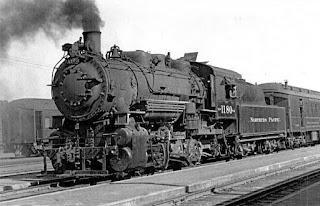 |
| Garfield County Courthouse, Pomeroy, Washington. Vintage postcard |
But Henry died in December 1923, leaving Barbara and son Alfred to run the farm. She did have one source of contentment. Finally, at the age of 32, Alfred had gotten married, and to a nice German girl who had once lived just five doors away. Twenty-two years old, Ida Behlau was the second oldest daughter in a family that had come to Pomeroy straight from Germany in 1909. The father died three years later, but the mother had married a local man the following year. Ida left the area in late 1922 or early 1923.
Then, in March 1924, she returned to Pomeroy and quickly married Alfred, on the 19th. Available news reports don’t say that the two had courted before, but that seems highly likely. The marriage was performed in Lewiston, Idaho, about 28 miles east of Pomeroy. As we’ll see, that was most likely to complete the ceremony as soon as possible. After the wedding, they had rejoined Mother Waldman at the farm.
Thursday, April 3 was cool, in the mid- to high-forties, with a breeze from the southwest. That evening, Alfred walked to the door to answer a knock. The stranger standing outside said, “Here’s a letter for you.”
Curious, Ida had followed him. Looking over his shoulder, she screamed. The stranger instantly shot her husband, and then her. Knowing only that something was terribly wrong, Barbara Waldman hurried toward the telephone … and the man shot her too. The door closed, and she tried again to reach the phone. Moments later, the killer returned, shot her four more times, then left.
Despite her wounds, Barbara found the phone and gasped out the awful news. In short order, every man in Pomeroy, armed with rifles and shotguns, was out looking for the shooter. Luckily, the stranger had asked several people how to get to the Waldman place, so officials were soon able to put out his description. Ralph M. Waller was captured the very next day in Lewiston.
The day after that, the Garfield County sheriff hurriedly transferred his prisoner to the state prison at Walla Walla to avoid a possible lynching. Even before he was moved, Waller confessed freely to the shootings and told a bizarre story. The strange account would need verification for the jury trial required for a capital crime. Thus, on April 8, officials contracted with criminologist Luke S. May to investigate. The next day, May was in Walla Walla to hear Waller’s story first-hand.
He then set out to assess the account, along with other evidence officials had collected. That included Waller’s weapon as well as some torn-up letters. Authorities hoped he’d find fingerprints on the letters, but none could be retrieved. However, May’s analysis of the handwriting and content showed that the letters had been written by Ida (Behlau) Waldman and addressed to Waller. Her words supported, and added to, Ralph’s narrative.
Born around 1890 in German Bohemia, Waller probably came to this country as a child. When he grew up, he worked mostly in Butte, Montana, as a miner. But he also moved around a lot, including trips out to California. News reports did not say if he was seeking better-paying work, liked to visit scattered family members, or simply had a bit of wanderlust.
In February 1921, Ralph married Ida’s older (by a year) sister Lucille. The ceremony took place in Spokane and it’s not clear that anyone else in the family had actually met Ralph. In any case, Ida visited the couple in Butte about a year or so after the marriage. Ralph discovered he liked the sister better than his wife, and she was attracted to him. No one ever explained what the living arrangements became after that. However, by the end of 1923, Ida and Ralph had an “understanding” that she would marry him as soon as Lucille gave him a divorce.
The following spring, Ralph and Ida left Lucille in California and headed north. They separated at some point, and Ralph went on to Butte. Ida, of course, returned to Pomeroy and married Alfred. Ralph called that a “double-cross” of their “agreement.” However, her letters to him showed that, as May put it in his report, “Ida was evidently in a delicate condition through living with Waller.”
May’s notes do not suggest how far advanced she was in her pregnancy. Still, she surely must have decided she did not have time for Ralph to get a divorce. But Ralph was infuriated when he heard the news and raced back. Along the way, he bought a gun in a small town about 30 miles from Pomeroy (easily traced, later). May quickly verified the death weapon, including one particular feature. The action was cranky and the gun would sometimes misfire. He asked Waller about that, and the killer agreed that “it did not always fire the cartridge the first time he pulled the trigger.”
Since the evidence was so conclusive, May did not feel they would need him at the trial. (A considerable savings for the county, since May charged $100 per day, plus expenses, when he had to appear in court.) Authorities originally planned to expedite the trial. However, they held off a few weeks when doctors said that Barbara Waldman, a tough pioneer lady, would soon recover enough to testify in court.
The trial was the expected formality, and Waller refused to appeal. The killer went to the gallows on the morning of June 27, 1924, less than three months after the shooting.
| References: Paula Becker, “Pomeroy – Thumbnail History,” Online Encyclopedia of Washington State History, HistoryLink.org, Seattle, Washington (September 24, 2010). |
| Luke S. May, Luke S. May Papers, Special Collections, University of Washington, Seattle, Washington (1969). |
| “[Waldman Murder News],” Seattle Times, Bellingham Herald, Washington; The Oregonian, Portland (April 4, 1924 – June 27, 1924). |

